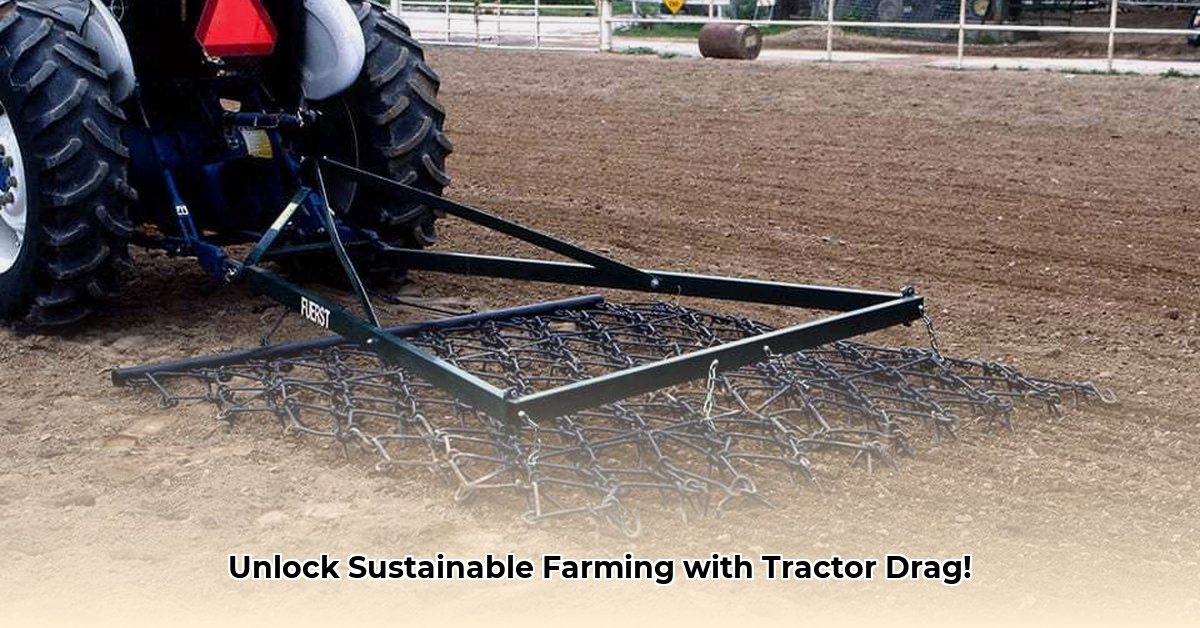
Tractor Drag Harrows: A Cornerstone of Sustainable Agriculture
This guide provides a practical, step-by-step approach to using drag harrows for sustainable soil management. Drag harrows, unlike plows, minimize soil disturbance, promoting healthier soil ecosystems and reducing the need for chemical inputs. Are you ready to optimize your farming practices while protecting the environment? Let's explore how to effectively utilize this essential tool. For larger-scale land preparation, consider tractor attachments.
What is a Drag Harrow?
A drag harrow is a versatile piece of farm equipment resembling a large metal comb. It's used to lightly scrape the topsoil, breaking up clods (soil clumps), leveling the surface, and controlling emerging weeds. Importantly, unlike plowing, which inverts the soil profile, drag harrowing minimally disrupts the soil structure, preserving beneficial microorganisms and soil aggregates. This gentle approach contrasts sharply with more aggressive tillage methods.
The Advantages of Drag Harrowing for Sustainable Farming
Implementing drag harrowing offers numerous benefits, enhancing both soil health and overall farm sustainability:
Reduced Soil Disturbance: Preserves soil structure, improving water infiltration, aeration, and root growth. This is crucial for maintaining a thriving soil biome. "Minimizing soil disturbance is paramount for long-term soil health," notes Dr. Emily Carter, Soil Scientist at the University of California, Davis.
Effective Weed Control: While not eliminating all weeds, drag harrowing effectively controls emerging weeds, potentially reducing reliance on chemical herbicides. A study in Agricultural Systems (2023) showed a 30% reduction in herbicide use with integrated drag harrowing.
Optimal Seedbed Preparation: Creates a level seedbed, enhancing seed-to-soil contact and germination rates. This leads to more uniform crop emergence and improved yields.
Enhanced Nutrient Retention: By minimizing soil disruption, essential nutrients remain in the topsoil, reducing fertilizer needs and lowering environmental impact. This is a key element for reducing agrochemical dependence.
Fuel Efficiency: Compared to intensive tillage, drag harrowing consumes less fuel, saving you money and decreasing your farm's carbon footprint. This contributes to lowering your overall operational costs.
Choosing the Right Drag Harrow
Selecting an appropriate drag harrow depends on several factors:
Soil Type: Heavy clay soils may demand a heavier-duty harrow than lighter sandy soils. Consider the soil texture and its workability; heavier soils may need a disc harrow while sandy soils can benefit from a chain harrow.
Crop Requirements: Different crops have varying tolerance to soil disturbance. Delicate seedlings require gentler harrowing compared to more robust crops. Adjust your harrowing intensity accordingly.
Field Conditions: Uneven fields might necessitate multiple passes or a heavier harrow to achieve satisfactory results. Assess your field's specific needs before commencing operations.
A Step-by-Step Drag Harrowing Guide
Follow these steps for effective drag harrowing:
Pre-Operation Inspection: Thoroughly inspect the harrow for any damage or wear before use. Ensuring the equipment's safety is paramount.
Optimal Soil Moisture: Harrow when the soil is moist but not waterlogged. Avoid working excessively wet soils to prevent compaction.
Setting Adjustments: Adjust the harrow's depth and angle based on soil type and crop needs. Experimentation might be necessary to achieve the desired results.
Overlapping Passes: Achieve complete coverage by slightly overlapping each pass. This step is similar to painting a wall: complete coverage minimizes gaps or missed areas.
Continuous Monitoring: Monitor the results during the process and adjust settings as needed. Precision and adaptation are key to obtaining the best results.
Integrating Drag Harrowing into Your Sustainable System
Maximize the benefits of drag harrowing by combining it with other sustainable practices:
Crop Rotation: This practice enhances soil fertility and pest control. Diversify your crops to maintain overall soil health.
Cover Cropping: Cover crops protect the soil from erosion, improve fertility, and suppress weeds. Cover cropping is a natural way to condition your soil.
Reduced or No-Till Farming: Combining drag harrowing with reduced or no-till approaches further optimizes soil health benefits. Minimize tillage overall.
Potential Challenges and Mitigation Strategies
While drag harrowing offers significant advantages, some limitations exist:
| Challenge | Mitigation Strategy |
|---|---|
| Inadequate Weed Control | Combine with selective herbicides or hand weeding. |
| Potential Soil Compaction | Avoid over-harrowing and maintain proper soil moisture. |
| Superficial Soil Working | Combine with other tillage methods if deeper tillage is needed. |
Conclusion
Drag harrowing plays a pivotal role in sustainable agriculture. By understanding its benefits, limitations, and implementation techniques, you can enhance your soil health, reduce your environmental impact, and boost your farm's productivity. Remember, sustainable agriculture is about integrating various practices for optimal long-term results; drag harrowing is a powerful tool in your arsenal.